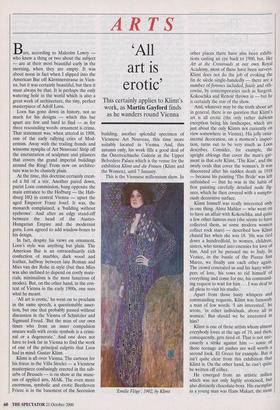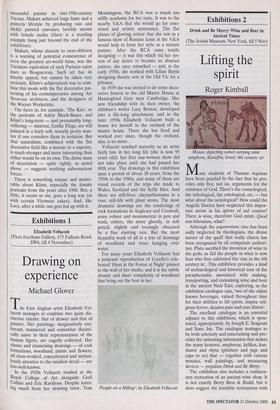ARTS `All
art is erotic'
Bars, according to Malcolm Lowry who knew a thing or two about the subject — are at their most beautiful early in the morning, when they are empty. It was about noon in fact when I slipped into the American Bar off Karntnerstrasse in Vien- na, but it was certainly beautiful, but then it must always be that. It is perhaps the only watering hole in the world which is also a great work of architecture, the tiny, perfect masterpiece of Adolf Loos.
Loos has gone down in history, not so much for his designs — which this bar apart are few and hard to find — as for three resounding words: ornament is crime. That statement was, when uttered in 1908, one of the early rallying cries of Mod- ernism. Away with the trailing fronds and winsome nymphs of Art Nouveau! Strip off the encrustation of sculpture and pilasters that covers the grand imperial buildings around the Ring! From now on architec- ture was to be chastely plain.
At the time, this doctrine certainly creat- ed a bit of a stir. Another pared down, purist Loos commission, bang opposite the main entrance to the Hofburg — the Hab- sburg HQ in central Vienna — upset the aged Emperor Franz Josef. It was, the monarch complained, a 'building without eyebrows'. And after an edgy stand-off between the head of the Austro- Hungarian Empire and the modernist guru,.Loos agreed to add window-boxes to his design.
In fact, despite his views on ornament, Loos's style was anything but plain. The American Bar is an extraordinarily rich confection of marbles, dark wood and leather, halfway between late Roman and Mies van der Rohe in style (but then Mies was also inclined to depend on costly mate- rials; minimalism is the most luxurious of modes). But, on the other hand, in the con- text of Vienna in the early 1900s, one sees what he meant.
`All art is erotic,' he went on to proclaim in the same speech, a questionable asser- tion, but one that probably passed without discussion in the Vienna of Schnitzler and Sigmund Freud. 'But the man of our own times who from an inner compulsion smears walls with erotic symbols is a crimi- nal or a degenerate.' And one does not have to look far in Vienna to find the work of one of the principal culprits that Loos had in mind: Gustav Klimt.
Klimt is all over Vienna. The cartoon for his frieze in the Villa Stoclet — a Viennese masterpiece confusingly erected in the sub- urbs of Brussels — is on show at the muse- um of applied arts, MAK. The even more enormous, symbolic and erotic Beethoven Frieze is in the basement of the Secession building, another splendid specimen of Viennese Art Nouveau, this time more suitably located in Vienna. And, this autumn only, his work fills a good deal of the Osterreichische Galerie in the Upper Belvedere Palace which is the venue for the exhibition Klimt and die Frauen (Klimt and the Women), until 7 January.
This is the Viennese millennium show. In Emilie Fltige, 1902, by Klimt other places there have also been exhibi- tions casting an eye back to 1900, but, like Art at the Crossroads at our own Royal Academy, most of these have been surveys. Klimt does not do the job of evoking the fin de siècle single-handedly — there are a number of femmes included, fatale and oth- erwise, by contemporaries such as Sargent, Kokoschka and Renoir thrown in — but he is certainly the star of the show.
And, whatever may be the truth about art in general, there is no question that Klimt's art is all erotic (the only rather dubious exception being his landscapes, which are just about the only Klimts not currently on view somewhere in Vienna). His jolly orna- mental decoration, on a moment's inspec- tion, turns out to be very much as Loos describes. Consider, for example, the upright oblongs that cover the man's gar- ment in that echt Klimt, 'The Kiss', and the swirly ovals that cover the woman's. It was discovered after his sudden death in 1918 — because his painting 'The Bride' was left unfinished — that he was in the habit of first painting carefully detailed nude fig- ures, which he then covered with a sumptu- ously decorative surface.
Klimt himself was really interested only in one thing. Alma Mahler — who went on to have an affair with Kokoschka, and quite a few other famous men (she seems to have collected them, as some modern women collect rock stars) — described how Klimt chased her when she was 18. 'He was tied down a hundredfold, to women, children, sisters, who turned into enemies for love of him. And yet he pursued me to Italy. In Venice, in the bustle of the Piazza San Marco, we finally saw each other again. The crowd concealed us and his hasty whis- pers of love, his vows to rid himself of everything and come for me, his command- ing request to wait for him ... I was deaf to all pleas to visit his studio.' Apart from those hasty whispers and commanding requests, Klimt was famously a man of few words. 'I am interested,' he wrote, 'in other individuals, above all in women.' But should we be interested in him?
Klimt is one of those artists whom almost everybody loves at the age of 19, and then, consequently, gets tired of, That is not nec- essarily a strike against him — some of those teenage art pashes are well worth a second look, El Greco for example. But it isn't quite clear from this exhibition that Klimt is. On the other hand, he can't quite be written off either.
He emerged from an artistic milieu which was not only highly eroticised, but also distinctly chocolate-boxy. His exemplar as a young man was Hans Makart, the most successful painter in late-19th-century Vienna. Makart achieved huge fame and a princely lifestyle by producing vast and slickly painted canvases, lavishly strewn with female nudes (there is a startling example hung just beyond the end of the exhibition).
Makart, whose descent to near-oblivion is a warning of potential evanescence of even the greatest art-world fame, was the Viennese equivalent of such Parisian salon stars as Bouguereau. Such art has its kitschy appeal, but cannot be taken very seriously. Klimt's achievement was to com- bine this mode with the flat decorative pat- terning of his contemporaries among Art Nouveau architects, and the designers of the Wiener Werkstatte.
The faces in, for example, 'The Kiss', or the portraits of Adele Bloch-Bauer, and Klimt's long-term — and presumably long- suffering — mistress, Emilie FlOge, are still painted in a fairly soft, woozily pretty man- ner if one considers them in isolation. But that naturalism, combined with the flat decorative field like a mosaic or a tapestry, is much stronger and more interesting than either would be on its own. The dense mass of decoration — quite rightly, as noted above — suggests seething subconscious forces.
There is something unique and memo- rable about Klimt, especially the female portraits from the years after 1900. But, a little, it seems to me, goes a long way (as with certain Viennese cakes). And, like Loos, after a while one gets fed up with it.


























































































 Previous page
Previous page